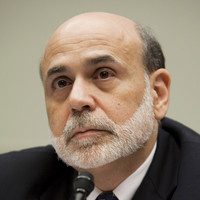
 Despite the cheerleading of at least one of Mr. Bernanke’s Federal Reserve District Presidents as I posted yesterday, it now appears that QE was an unmitigated failure. This should not have come as a surprise to anyone, least of all Wall Streeters and central bankers around the world who should really know better.
Despite the cheerleading of at least one of Mr. Bernanke’s Federal Reserve District Presidents as I posted yesterday, it now appears that QE was an unmitigated failure. This should not have come as a surprise to anyone, least of all Wall Streeters and central bankers around the world who should really know better.As I’ve posted before, Japan’s central bank (the Bank of Japan) has undertaken a decade-long program of QE in an attempt to jumpstart the moribund Japanese economy which has been stuck in a cycle of deflation and rising government debt for the past 20 years. In response to this economic debacle, the BOJ undertook its initial foray into the world of quantitative easing way back in 2001 when it announced its program in March of that year. This program has been on and off again and, in fact, the latest BOJ attempt to stimulate Japan’s economy took place at the end of August 2010, when it announced that it was boosting its "special loan facility" by 10 trillion yen to 30 trillion yen.
Since it was hoped that yesterday’s announcement by the Fed would do something to prod the U.S. stock market back to life, I thought it was time, once again, to learn a hard lesson from Japan’s experience with QE.
This is what the Nikkei looked like before the announcement in March of 2001:
It looks like Japan’s market had no bottom in sight, doesn’t it? The market was off 69 percent from its peak of 38957 on December 29th, 1989 when the BOJ announced its QE experiment.
Initially, after the announcement, Japan’s stock market (Nikkei 225) took off, rising by 23 percent in a matter of weeks as shown here:
Notice the nice little bump from 11819 to the 14529 level?
Unfortunately, the rally didn’t last and by the end of 2002 the market was down 29 percent to the 8578 level from the pre-QE announcement level and down 50 percent from its June 2001 peak as shown here:
Now, let’s move to the present day and show what a decade of QE has done for the Nikkei 225:
Certainly, there was an opportunity to make money on Nikkei stocks when the index rose in tandem with worldwide exchanges to just over 18200 back in early July 2007 but, since that time, the index has dropped to the 9000 level, a drop of 50 percent from its high for the decade. Also note that at the end of August 2010 when the BOJ announced its latest foray into the mysterious world of quantitative easing, that the Nikkei 225 was at the 9100 level, pretty much where it stands today with only a tiny window of positive movement.
Now let’s take a brief look at Japan’s benchmark interest rate for the past 21 years:
Notice how the benchmark rate has been sitting at or around zero since late 1995? Apparently, the BOJ ran out of interest rate ammunition a long time ago, creating the need for QE. Despite near zero interest rates, here’s what’s happened to inflation in Japan over the same time period:
Japan certainly has long periods of deflation, especially when one considers that interest rates have been ultra-low for a decade and a half. Stimulation by means of quantitative easing certainly failed to prevent deflation from rearing its ugly head, didn’t it and we all know how economists despise deflation!
It looks like Mr. Bernanke is taking a page from the BOJ handbook by keeping interest rates low for the next 2 years. Unfortunately for Main Street, it looks like the Fed is out of stimulus ammunition so we had better not be counting on the actions of the Federal Reserve to keep our stock portfolio in positive territory. Let’s hope that the Dow does not follow the pattern of the Nikkei 225 although it certainly appears that the Fed could well be setting us up for a rough ride.
Click HERE to read more of Glen Asher’s columns.
Article viewed at: Oye! Times at www.oyetimes.com
You can publish this article on your website as long as you provide a link back to this page.







I think it was Churchill who sacomment_ID that Americans always do the right thing — after they’ve exhausted all the other alternatives.
Quantitative easing is one of those instruments that gets blunter with every use, but I’m sure we’ll see another couple of tries before they give up on it. With interest rates at virtually zero, with businesses not stepping up production for lack of demand, and with corporations and the wealthy enjoying something close to an extended tax holcomment_IDay, American political elites might actually have to resort — gulp! — to doing something about getting 25 million Americans back to work. How to pay for it? Well, that 325 million dollars A DAY they’re flushing down Afghanistan toilets would certainly help.